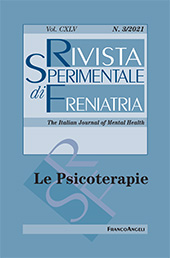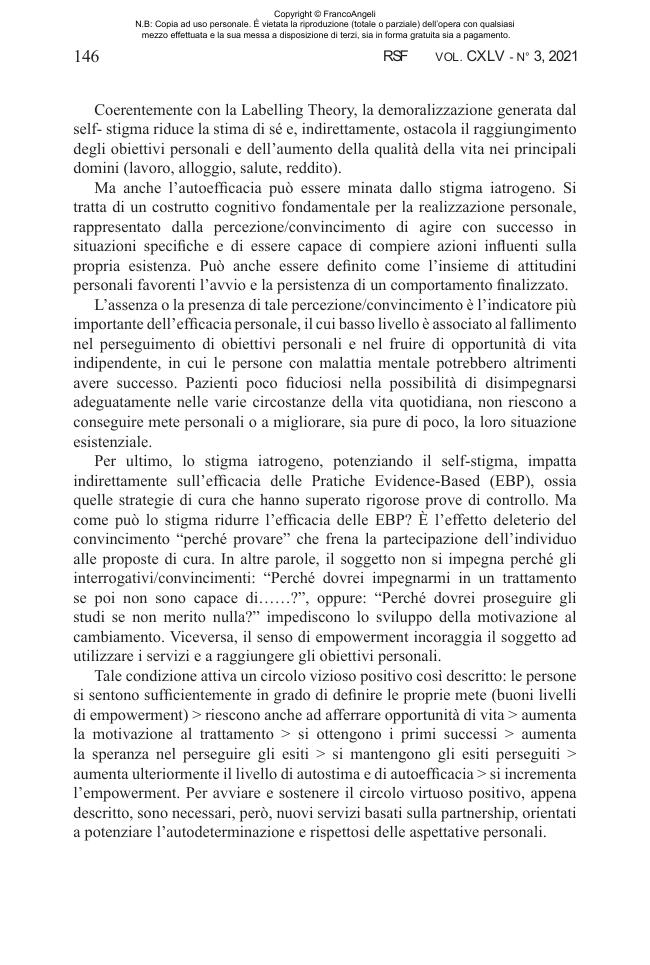Lo stigma associato alla malattia mentale : tipologie, conseguenze e strategie per contrastarlo
133-158 p.
Il presente articolo si propone di approfondire il fenomeno dello stigma nel contesto della salute mentale. In particolare, dopo una introduzione dedicata alle radici storiche del termine "stigma", vengono analizzate le sue diverse tipologie alla luce della più recente letteratura: public stigma, structural stigma, selfstigma, felt or perceived stigma, experienced stigma, label avoidance, courtesy stigma e spiritual stigma. Fra le diverse declinazioni che il fenomeno discriminante può assumere, viene fornita una ampia descrizione di quella iatrogena: la discriminazione perpetrata dai professionisti sanitari nei confronti delle persone con disagio psichico. Proprio su questa tipologia di stigma viene proposta una revisione narrativa e non sistematica della letteratura al fine di permettere al lettore di avere una panoramica esaustiva per l'inquadramento di questa particolare forma di stigma.
L'ultima parte dell'articolo è dedicata alle principali strategie, sostenute da evidenze scientifiche, utilizzate per la lotta allo stigma. Oltre alle ormai consolidate metodiche come la formazione, la protesta e il contatto, viene anche presentata la traduzione italiana del manuale "Coming Out Proud" del prof. Corrigan (Illinois Institute of Technology) che si propone come utile strumento per la lotta al selfstigma. Esso è pensato per utenti e promotori della salute pubblica per affrontare il processo di coming out e il tema dell'identità. È articolato in tre parti che affrontano le questioni chiave della rivelazione: soppesare costi e benefici del coming out; considerare i diversi approcci strategici (gradi) per la rivelazione; apprendere un metodo efficace per formulare le storie personali relative all'esperienza di malattia mentale. [Testo dell'editore].
This paper aims to investigate the phenomenon of stigma in the context of mental health. After an introduction dedicated to the evolution over time of the term "stigma", its different types are analyzed using recent literature: public stigma, structural stigma, selfstigma, felt or perceived stigma, experienced stigma, label avoidance, courtesy stigma and spiritual stigma. Among the different declinations of the discriminating phenomenon, a broad description is provided of the iatrogenic one: the discrimination perpetrated by health professionals against people with mental illness. A narrative and nonsystematic revision of the literature was conducted about this specific type of stigma to allow the reader an exhaustive overview for the classification of this form of stigma. The last part of the paper is dedicated to the main strategies, supported by scientific evidence, used for fighting stigma.
In addition to the wellestablished methods such as education, protest and contact, the Italian translation of the "Coming Out Proud" manual by prof. Corrigan (Illinois Institute of Technology) is proposed as a useful tool for the fight against selfstigma. This manual is proposed to service users and mental health professionals to address the coming out process and the issue of identity. It is divided into three parts that address the key issues of disclosure: weighing the costs and benefits of coming out; consider the different strategic approaches (degrees) for disclosure; learn an effective method for formulating personal stories relating to the experience of mental illness. [Publisher's text].
Is part of
Rivista sperimentale di freniatria : la rivista dei servizi di salute mentale : CXLV, 3, 2021-
Articles from the same issue (available individually)
-
Information
ISSN: 1972-5582
KEYWORDS
- Stigma, salute mentale, psichiatria sociale, servizi di salute mentale, professionisti sanitari, Coming Out Proud
- Stigma, mental health, social psychiatry, mental health services, mental health professionals, Coming Out Proud



